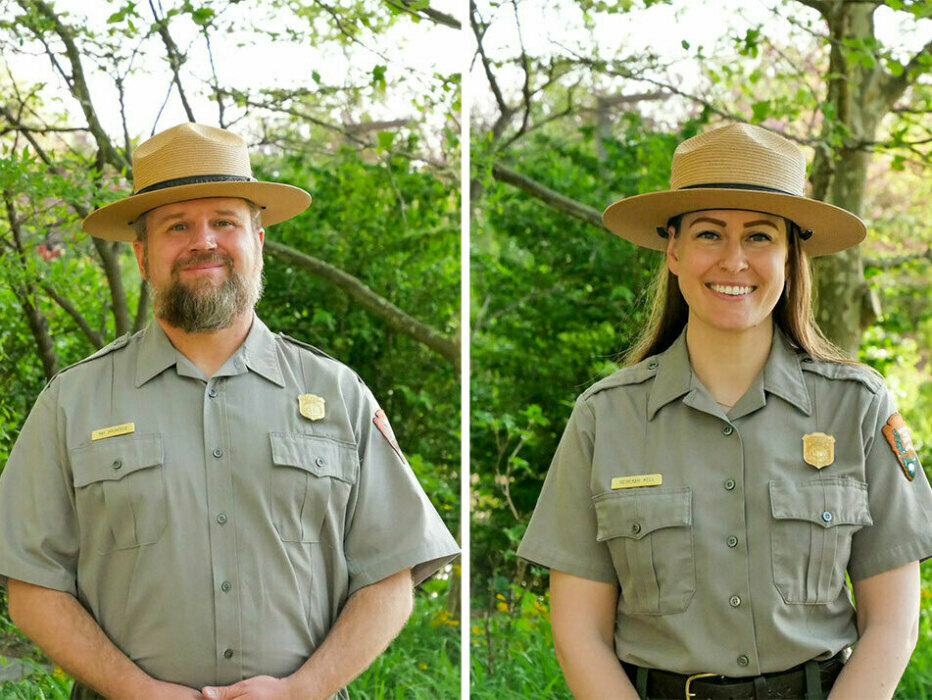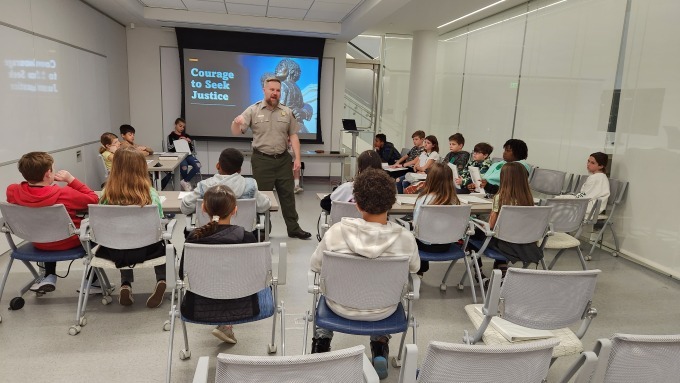Updates / News /


Updates / News /

This article was originally published in our spring 2023 newsletter, View 630'.
In 2022, the Foundation expanded its partnership with Gateway Arch National Park through a new undertaking: funding two permanent, full-time National Park Service (NPS) education specialist positions.
As an NPS philanthropic partner, the Foundation has been involved in education at the park for some time through the Journey Fund and by supporting programs like Reading with a Ranger and Paddle Your Park. This expansion will continue to further the opportunities that students and teachers have while visiting the park, and the two new NPS team members hired in the fall are sure to make those visits enriching.
We caught up with Gateway Arch National Park’s education director Matt Easley and the new education specialists, Ray Brundege and Rebekah Kell, to learn more about their roles and goals at the park.
Before joining Gateway Arch National Park’s team about six months ago, Ray Brundege was the anti-terrorism program manager at Scott Air Force Base. He had accepted that job after being a park ranger in state parks in North Carolina at Hanging Rock State Park and Tennessee at Burgess Falls State Park and Window Cliffs State Natural Area. Over the years, he had volunteered a little with NPS but says he mostly volunteered in state parks, military museums and United Service Organizations (USOs). He was drawn to parks because of a love of history and of the outdoors.
“And the fact that you get to do both in one entity is pretty awesome,” he said.
“I was drawn to Gateway Arch National Park because I love the location and the Old Courthouse,” he continued. “It broadens my abilities in parks and recreation by being in an urban setting; Gateway Arch National Park has everything — it is cultural, recreational and natural.”
Coming from the East Coast and his wife from the West Coast, Brundege appreciates St. Louis’ centralized location.
“I’ve always loved St. Louis,” he said. “My dad’s originally from Missouri, so I’m a huge Cardinals fan and have been my whole life. I love the history of it.”
Outside of this park, Brundege says his other favorite national park sites are Harpers Ferry National Historic Site, Shenandoah National Park, Congaree National Park, George Washington Memorial Parkway and Big South Fork National River and Recreation Area.
“Every major life event or decision I have ever made has either had a state or national park tied to it in some way, shape or form,” he said.
Rebekah Kell, on the other hand, has a teaching background and had her first professional park experience completing the internship program at Gateway Arch National Park. She learned about all the opportunities within the National Park Service and was interested in joining as a permanent member when the education specialist position opened.
“Being able to be involved and create educational products and programs that can reach a lot of different areas and underserved communities was a draw for me,” she said.
Kell is a native St. Louisan and appreciates the Arch as a representation of the people here.
“Everybody collectively just loves the Arch so much; it’s just that broader sense of community. Every area in St. Louis is so different, and there are so many municipalities, but then there are those big things that make you truly a St. Louisan that tie everybody together.”

Brundege and Kell have hit the ground running leading educational opportunities and embracing interaction with the public.
One of Kell’s favorite experiences so far has been with the Every Kid Outdoors program, in which rangers go into the classrooms for “pre-visits” before students visit the park. During the pre-visit, rangers introduce them to the National Park Service and discuss what to expect during their field trips.
“Then they come here about a week later, and they’re always excited to see whoever they’ve seen in the classroom, so that’s really rewarding,” she said.
“I love being on the floor, working the theater desk,” Brundege said. “I’m a big fan of when the kids come here, showing them around even if they aren’t scheduled for a ranger tour, or if the teacher looks lost, I can help.”
Brundege says he loves the research aspect of the position, too, researching the history and natural sciences of Missouri and Illinois.
“Even though my background is in history, my first two parks were natural science parks, where the staff were very much ‘weeds and seeds,’ so I’m a huge civilian conservation corps fan, and I’m an Illinois state naturalist apprentice. Being in an urban area, I’ve really enjoyed learning about the WPA [Works Progress Administration, a New Deal Agency whose workers helped site preparation for the Jefferson National Expansion Memorial], as well, and civil rights cases, too.”
“For me, it’d be Colonial St. Louis or Manifest Destiny,” Brundege said, referencing two of the six permanent galleries. “Jefferson’s Vision is very pleasing to the eye and very spread out.”
“I really like the [French colonial log] cabin and that it highlights Jeanette Forchet,” Kell said. “I’m from here and had never heard about her until I got into the Museum. I also really like the Old Rock House; it’s just such a unique thing and it’s actually here.”
Asked what St. Louisans would be most surprised by at the park, both referred to historical events featured in the Museum.
“The Battle of St. Louis,” Brundege said. “I think I said in my interview I was really stoked about that.”
“The historic ownership of St. Louis — it changed hands three different times,” said Kell. “A lot of the French influence can still be seen in St. Louis, but it’s not front-facing, and a lot of people are surprised by that.”
Easley says that as a national park, the educational programs have naturally focused on social studies and history, but that he believes the ground is fertile for more STEAM (science, technology, engineering, art and math) elements, with arts, sciences and engineering going hand in hand. He shares examples of new ideas Kell and Brundege are exploring for future programming around themes of engineering and writing.
“Nobody ever really talks about engineering throughout the course of history,” Kell said. “In each [Museum] gallery, there’s a piece of something that has been engineered. There’s the [colonial] house and the Norman truss [a distinctive form of roof support used in Normandy], the teepee is its own thing as kind of an engineered structure. And then you have the steamboats, the stagecoach. You have Eads Bridge, and then you obviously have the Arch. And they kind of all fit into a theme: the first two galleries are dwellings, the next two are forms of transportation, and the next two are landmarks.”
Brundege is currently working on a project he calls “Lewis’ Living Journal,” using a spreadsheet to track and review all the plants Lewis documented across his journals, while also incorporating the journals of other members of the expedition, such as Patrick Gass. (Gass, he says, doesn’t get enough credit for his contributions — “for a layman, you can’t get any better.”)
“I’ve tied Native Americans into it, too, because they knew about it before Lewis; he just happened to document it,” he said. “So how the plants tie into the Native American uses … and looking at the medicinal aspects of some stuff they used and Lewis used, and do we still use it today?”
Brundege wants to create more opportunities for visiting students to get outside on the grounds and journal themselves, and he hopes to create stronger connections with folks who are learning about the Lewis and Clark expedition at the park outside of school settings, as well.
“I hope that by creating educational programs and doing student outreach, I can educate students about our park and the National Park Service as a whole and also hopefully foster a continued sense of curiosity in the parks and the world around them,” Kell said.
The students certainly have curiosity. When discussing the best question they’ve received, Brundege said one fourth-grader wrote a letter to ask “how babies were made going West on the trail.” “Of all the parks I’ve worked at, it’s going to be hard to top that.”
Easley says that before hiring Brundege and Kell, he had the usual nervous anticipation about whether he would find the right people for the roles, but he’s absolutely thrilled with the picks.
“They both bring an incredible depth of experience — it’s very diverse,” he said. “It’s going to be incredibly beneficial to the education department and the park in general. As we move forward and look to grow, the sky is the limit.”
By Maria Tsikalas
Portrait photos by Alex Bakken

New this year, our Premium Experience at Blues at the Arch Festival includes artist meet and greets, one-of-a-kind festival merch, and local food and drink - all in a cooled tent!
UPGRADE YOUR EXPERIENCE TODAY to enjoy the best that Blues at the Arch has to offer.
Blues In Style!